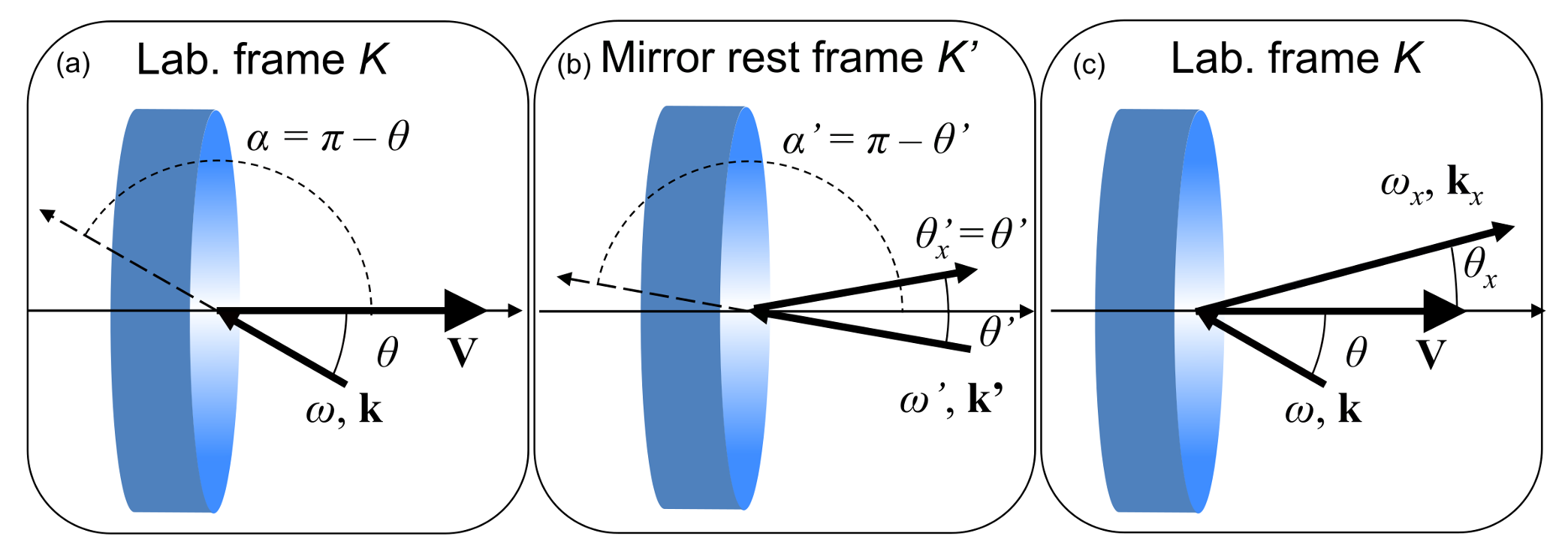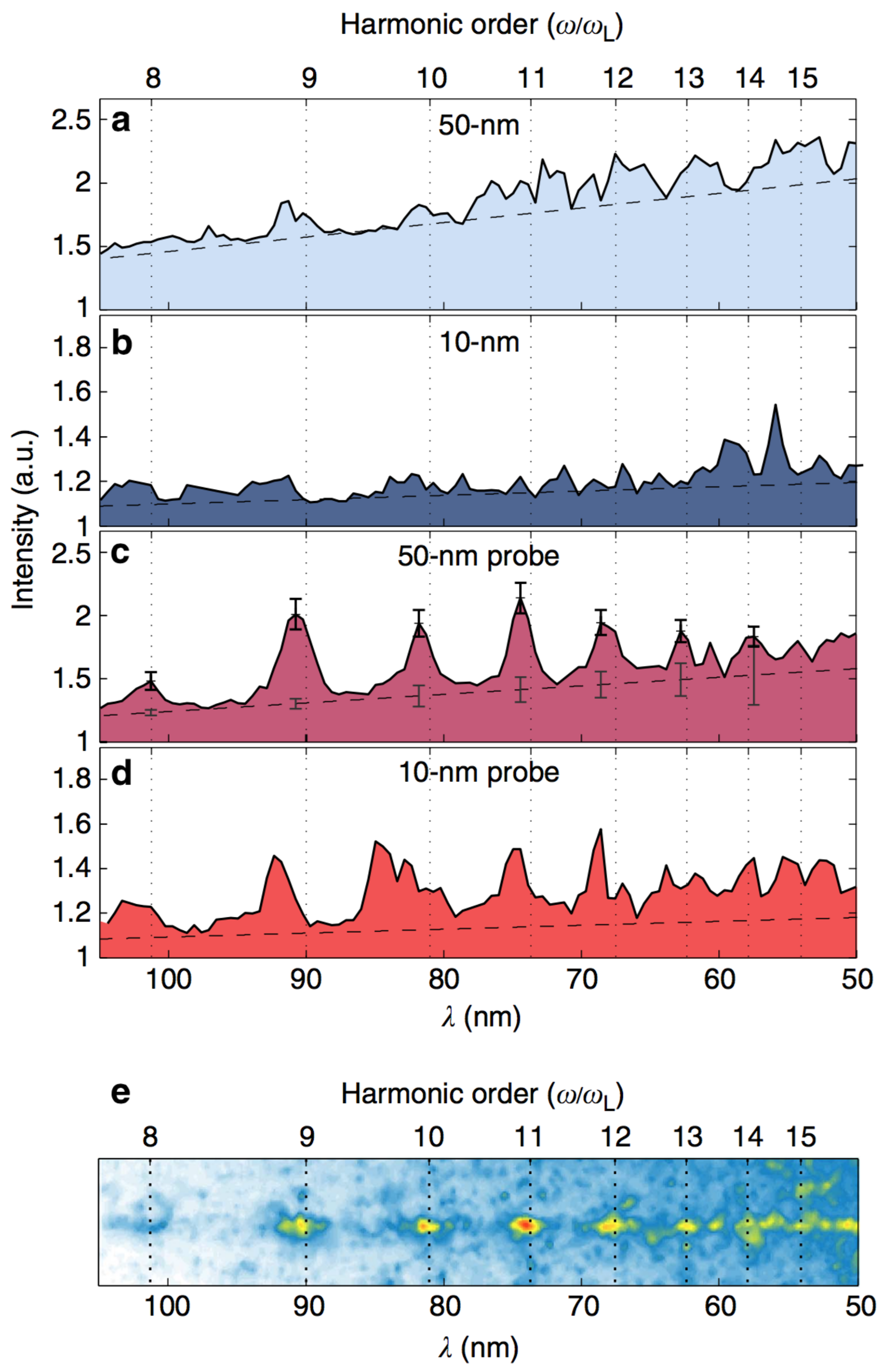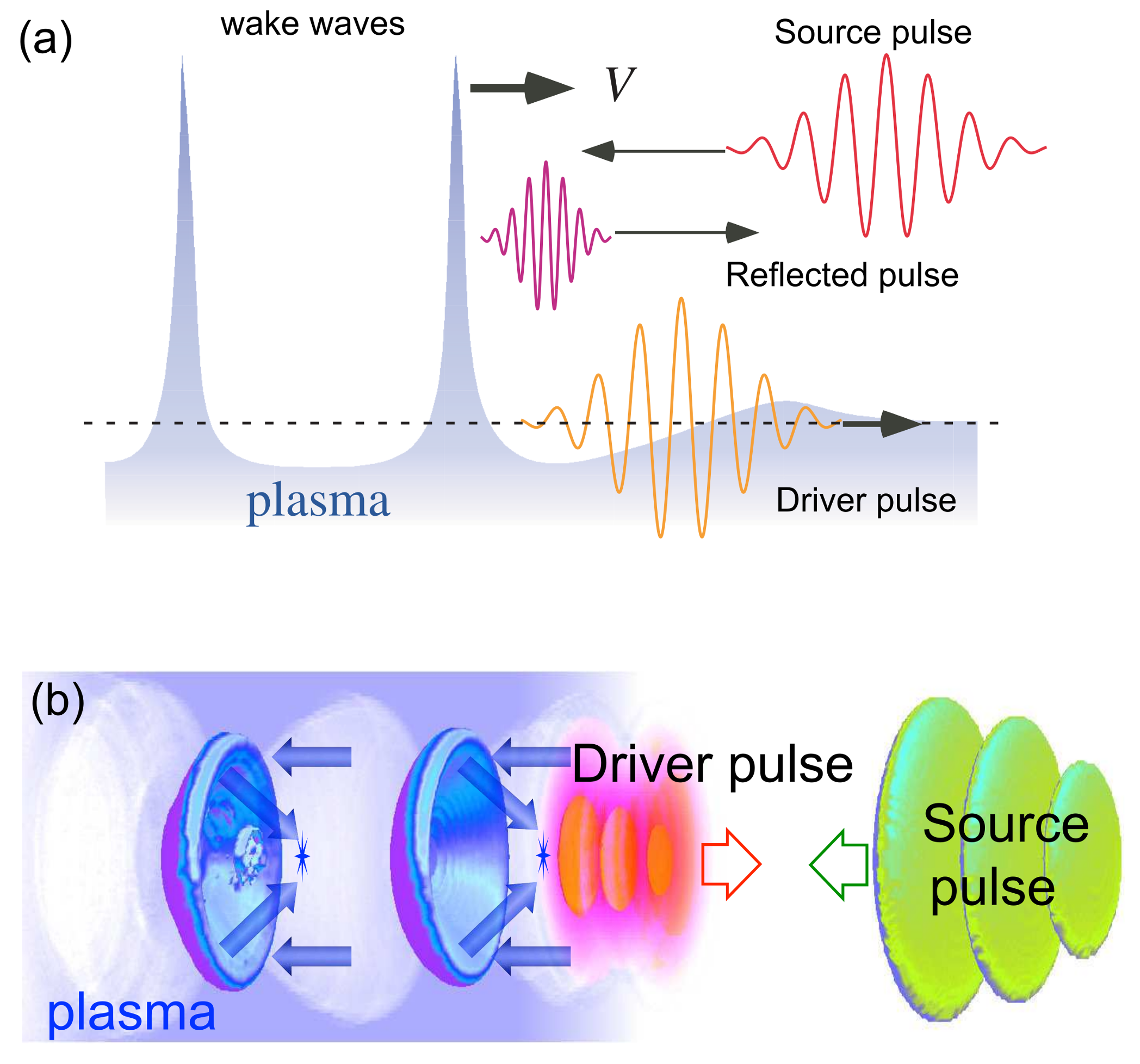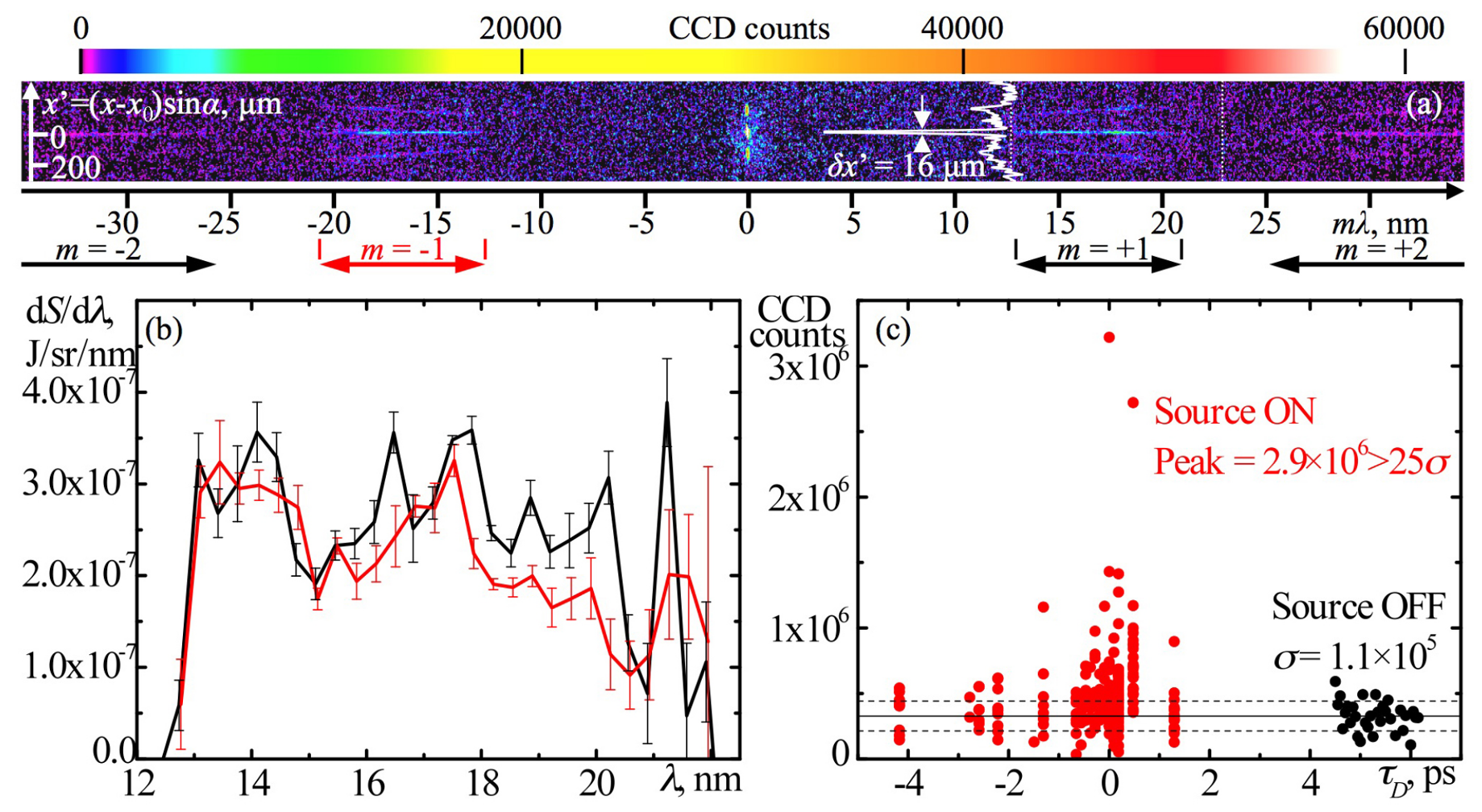Coherent, Short-Pulse X-ray Generation via Relativistic Flying Mirrors
Abstract
:1. Introduction
2. Theory of Relativistic Mirrors
3. Several Implementations of Relativistic Flying Mirrors
3.1. Relativistic Charged Beam
3.2. Propagating Ionization Front
3.3. Moving Boundary of Impedance in Nonlinear Transform Line
3.4. Moving Boundary of Electron-Hole Plasma in Semiconductors
3.5. Oscillating Mirror/Sliding Mirror
3.6. A Thin Foil Mirror Driven by an Intense Laser Light Pressure
3.7. Breaking Wake Waves
3.8. Superluminal Mirrors
4. Applications of Relativistic Flying Mirrors
5. Conclusions
Acknowledgments
Conflicts of Interest
References
- Einstein, A. Zur Elektrodynamik bewegter Körper. Annalen Phys. 1905, 322, 891–921. [Google Scholar] [CrossRef]
- Kando, M. Light reflection from mirror moving at relativistic speed—Reflection and frequency-upshifting pf electromagnetic waves from wake waves produced through laser-plasma interaction. J. Plasma Fusion Res. 2010, 86, 164–168. [Google Scholar]
- Bulanov, S.V.; Esirkepov, T.Z.; Kando, M.; Pirozhkov, A.S.; Rosanov, N.N. Relativistic mirrors in plasmas. Novel results and perspectives. Phys. Usp. 2013, 56, 429–464. [Google Scholar] [CrossRef]
- Motz, H. Applications of the Radiation from Fast Electron Beams. J. Appl. Phys. 1951, 22, 527–535. [Google Scholar] [CrossRef]
- Granatstein, V.L.; Sprangle, P.; Parker, R.K.; Pasour, J.; Herndon, M.; Schlesinger, S.P.; Seftor, J.L. Realization of a relativistic mirror: Electromagnetic backscattering from the front of a magnetized relativistic electron beam. Phys. Rev. A 1976, 14, 1194–1201. [Google Scholar] [CrossRef]
- Huang, Z.; Kim, K.J. Review of x-ray free-electron laser theory. Phys. Rev. Accel. Beams 2007, 10, 034801. [Google Scholar] [CrossRef]
- Sasao, N. Intense gamma radiation by accelerated quantum ions. In Proceedings of the Light driven Nuclear-Particle Physics and Cosmology LNPC, Yokohama, Japan, 19–21 April 2017; pp. 1–19. [Google Scholar]
- Semenova, V. Reflection of electromagnetic waves from an ionization front. Radiophys. Quantum Electron. 1967, 10, 599–604. [Google Scholar] [CrossRef]
- Kuo, S. Frequency up-conversion of microwave pulse in a rapidly growing plasma. Phys. Rev. Lett. 1990, 65, 1000–1003. [Google Scholar] [CrossRef] [PubMed]
- Savage, R.; Joshi, C.; Mori, W. Frequency up-conversion of electromagnetic-radiation upon transmission into an ionization front. Phys. Rev. Lett. 1992, 68, 946–949. [Google Scholar] [CrossRef] [PubMed]
- Mori, W. Generation of tunable radiation using an underdense ionization front. Phys. Rev. A 1991, 44, 5118–5121. [Google Scholar] [CrossRef] [PubMed]
- Lai, C.; Liou, R.; Katsouleas, T.C.; Muggli, P.; Brogle, R.; Joshi, C.; Mori, W.B. Demonstration of microwave generation from a static field by a relativistic ionization front in a capacitor array. Phys. Rev. Lett. 1996, 77, 4764–4767. [Google Scholar] [CrossRef] [PubMed]
- Yugami, N.; Fujita, K.; Higashiguchi, T.; Nishida, Y. Experimental observation of short microwave generation via relativistic ionization front produced by CO2 laser. Jpn. J. Appl. Phys. 1998, 37, 688–689. [Google Scholar] [CrossRef]
- Higashiguchi, T.; Yugami, N.; Okabe, H.; Niiyama, T.; Takahashi, E.; Ito, H.; Nishida, Y. Emission of Short Microwave Pulse Radiated by Interaction between Periodic Static Electric Field and Relativistic Ionization Front. Jpn. J. Appl. Phys. 1999, 38, L527–L530. [Google Scholar] [CrossRef]
- Itoh, H.; Soda, K. Doppler Frequency Shift of an Electromagnetic Wave by a Fast Moving Boundary. OYO BUTURI 1999, 48, 616–622. [Google Scholar]
- Mu, L.; Donaldson, W.R.; Adams, J.C.; Falk, R.A. Electromagnetic wave interaction with laser-induced plasmas in GaAs. In Optically Activated Switching IV; Donaldson, W.R., Ed.; International Society for Optics and Photonics: Bellingham, WA, USA, 1995; pp. 107–113. [Google Scholar]
- Bae, J.; Xian, Y.J.; Yamada, S.; Ishikawa, R. Doppler frequency up conversion of electromagnetic waves in a slotline on an optically excited silicon substrate. Appl. Phys. Lett. 2009, 94, 091120. [Google Scholar] [CrossRef]
- Kohno, N.; Itakura, R.; Tsubouchi, M. Mechanism of relativistic Doppler reflection from a photoinduced moving plasma front studied by terahertz time-domain spectroscopy. Phys. Rev. B 2016, 94, 155205. [Google Scholar] [CrossRef]
- Bulanov, S.V.; Naumova, N.; Pegoraro, F. Interaction of an ultrashort, relativistically strong laser-pulse with an overdense plasma. Phys. Plasmas 1994, 1, 745–757. [Google Scholar] [CrossRef]
- Naumova, N.; Nees, J.; Sokolov, I.; Hou, B.; Mourou, G. Relativistic generation of isolated attosecond pulses in a λ3 focal volume. Phys. Rev. Lett. 2004, 92, 063902. [Google Scholar] [CrossRef] [PubMed]
- Gordienko, S.; Pukhov, A.; Shorokhov, O.; Baeva, T. Relativistic Doppler effect: Universal spectra and zeptosecond pulses. Phys. Rev. Lett. 2004, 93, 115002. [Google Scholar] [CrossRef] [PubMed]
- Pirozhkov, A.S.; Bulanov, S.V.; Esirkepov, T.Z.; Mori, M.; Sagisaka, A.; Daido, H. Attosecond pulse generation in the relativistic regime of the laser-foil interaction: The sliding mirror model. Phys. Plasmas 2006, 13, 013107. [Google Scholar] [CrossRef]
- Pirozhkov, A.S.; Bulanov, S.V.; Esirkepov, T.Z.; Mori, M.; Sagisaka, A.; Daido, H. Generation of high-energy attosecond pulses by the relativistic-irradiance short laser pulse interacting with a thin foil. Phys. Lett. A 2006, 349, 256–263. [Google Scholar] [CrossRef]
- Dromey, B.; Zepf, M.; Gopal, A.; Lancaster, K.; Wei, M.S.; Krushelnick, K.; Tatarakis, M.; Vakakis, N.; Moustaizis, S.; Kodama, R.; et al. High harmonic generation in the relativistic limit. Nat. Phys. 2006, 2, 456–459. [Google Scholar] [CrossRef]
- Dromey, B.; Adams, D.; Hoerlein, R.; Nomura, Y.; Rykovanov, S.G.; Carroll, D.C.; Foster, P.S.; Kar, S.; Markey, K.; McKenna, P.; et al. Diffraction-limited performance and focusing of high harmonics from relativistic plasmas. Nat. Phys. 2009, 5, 146–152. [Google Scholar] [CrossRef]
- Nomura, Y.; Hoerlein, R.; Tzallas, P.; Dromey, B.; Rykovanov, S.; Major, Z.; Osterhoff, J.; Karsch, S.; Veisz, L.; Zepf, M.; et al. Attosecond phase locking of harmonics emitted from laser-produced plasmas. Nat. Phys. 2009, 5, 124–128. [Google Scholar] [CrossRef]
- Vincenti, H.; Quere, F. Attosecond Lighthouses: How to Use Spatiotemporally Coupled Light Fields to Generate Isolated Attosecond Pulses. Phys. Rev. Lett. 2012, 108, 113904. [Google Scholar] [CrossRef] [PubMed]
- Esirkepov, T.Z.; Bulanov, S.; Kando, M.; Pirozhkov, A.S.; Zhidkov, A.G. Boosted High-Harmonics Pulse from a Double-Sided Relativistic Mirror. Phys. Rev. Lett. 2009, 103, 025002. [Google Scholar] [CrossRef] [PubMed]
- Kulagin, V.V.; Cherepenin, V.A.; Hur, M.S.; Suk, H. Flying mirror model for interaction of a super-intense nonadiabatic laser pulse with a thin plasma layer: Dynamics of electrons in a linearly polarized external field. Phys. Plasmas 2007, 14, 113101. [Google Scholar] [CrossRef]
- Bulanov, S.S.; Maksimchuk, A.; Krushelnick, K.; Popov, K.I.; Bychenkov, V.Y.; Rozmus, W. Ensemble of ultra-high intensity attosecond pulses from laser–plasma interaction. Phys. Lett. A 2010, 374, 476–480. [Google Scholar] [CrossRef]
- Kiefer, D.; Yeung, M.; Dzelzainis, T.; Foster, P.S.; Rykovanov, S.G.; Lewis, C.L.; Marjoribanks, R.S.; Ruhl, H.; Habs, D.; Schreiber, J.; et al. Relativistic electron mirrors from nanoscale foils for coherent frequency upshift to the extreme ultraviolet. Nat. Commun. 2013, 4, 1763. [Google Scholar] [CrossRef] [PubMed] [Green Version]
- Bulanov, S.; Esirkepov, T.Z.; Tajima, T. Light intensification towards the Schwinger limit. Phys. Rev. Lett. 2003, 91, 085001. [Google Scholar] [CrossRef] [PubMed]
- Kando, M.; Fukuda, Y.; Pirozhkov, A.S.; Ma, J.; Daito, I.; Chen, L.; Esirkepov, T.Z.; Ogura, K.; Homma, T.; Hayashi, Y.; et al. Demonstration of laser-frequency upshift by electron-density modulations in a plasma wakefield. Phys. Rev. Lett. 2007, 99, 135001. [Google Scholar] [CrossRef] [PubMed]
- Pirozhkov, A.; Ma, J.; Kando, M.; Esirkepov, T.Z.; Fukuda, Y.; Chen, L.M.; Daito, I.; Ogura, K.; Homma, T.; Hayashi, Y.; et al. Frequency multiplication of light back-reflected from a relativistic wake wave. Phys. Plasmas 2007, 14, 123106. [Google Scholar] [CrossRef]
- Panchenko, A.V.; Esirkepov, T.Z.; Pirozhkov, A.S.; Kando, M.; Kamenets, F.F.; Bulanov, S.V. Interaction of electromagnetic waves with caustics in plasma flows. Phys. Rev. E 2008, 78, 056402. [Google Scholar] [CrossRef] [PubMed]
- Bulanov, S.V.; Esirkepov, T.Z.; Kando, M.; Koga, J.K.; Pirozhkov, A.S.; Nakamura, T.; Bulanov, S.S.; Schroeder, C.B.; Esarey, E.; Califano, F.; et al. On the breaking of a plasma wave in a thermal plasma. II. Electromagnetic wave interaction with the breaking plasma wave. Phys. Plasmas 2012, 19, 113103. [Google Scholar] [CrossRef]
- Kando, M.; Pirozhkov, A.S.; Kawase, K.; Esirkepov, T.Z.; Fukuda, Y.; Kiriyama, H.; Okada, H.; Daito, I.; Kameshima, T.; Hayashi, Y.; et al. Enhancement of Photon Number Reflected by the Relativistic Flying Mirror. Phys. Rev. Lett. 2009, 103, 235003. [Google Scholar] [CrossRef] [PubMed]
- Pirozhkov, A.S.; Kando, M.; Esirkepov, T.Z.; Fukuda, Y.; Chen, L.M.; Daito, I.; Ogura, K.; Homma, T.; Hayashi, Y.; Kotaki, H.; et al. Demonstration of Flying Mirror with Improved Efficiency. AIP Conf Proc. 2009, 1153, 274–284. [Google Scholar]
- Lampe, M.; Ott, E.; Waler, J.H. Interaction of electromagnetic waves with a moving ionization front. Phys. Fluids 1978, 21, 42–54. [Google Scholar] [CrossRef]
- Bu, Z.; Shen, B.; Huang, S.; Li, S.; Zhang, H. Light reversing and folding based on a superluminal flying mirror in a plasma with increasing density. Plasma Phys. Control. Fusion 2016, 58, 1–9. [Google Scholar] [CrossRef]
- Hashimshony, D.; Zigler, A.; Papadopoulos, K. Conversion of Electrostatic to Electromagnetic Waves by Superluminous Ionization Fronts. Phys. Rev. Lett. 2001, 86, 2806–2809. [Google Scholar] [CrossRef] [PubMed]
- Vshivkov, V.A.; Naumova, N.M.; Pegoraro, F.; Bulanov, S.V. Nonlinear electrodynamics of the interaction of ultra-intense laser pulses with a thin foil. Phys. Plasmas 1998, 5, 2727–2741. [Google Scholar] [CrossRef]
- Pirozhkov, A.S.; Esirkepov, T.Z.; Pikuz, T.A.; Faenov, A.Y.; Ogura, K.; Hayashi, Y.; Kotaki, H.; Ragozin, E.N.; Neely, D.; Kiriyama, H.; et al. Burst intensification by singularity emitting radiation in multi-stream flows. Sci. Rep. 2017, 7, 17968. [Google Scholar] [CrossRef] [PubMed]
- Saldin, E.L.; Schneidmiller, E.A.; Shvyd’ko, Y.V.; Yurkov, M.V. XFEL with a meV Bandwidth: Seeding Option; TESLA Technical Design Report; Deutschen Elektronen-Synchrotron Notkestrasse: Hamburg, Germany, 2001; Part V, Additional Material on CD-Rom; p. 332. [Google Scholar]
- Koga, J.K.; Bulanov, S.V.; Esirkepov, T.Z.; Pirozhkov, A.S.; Kando, M.; Rosanov, N.N. Possibility of measuring photon-photon scattering via relativistic mirrors. Phys. Rev. A 2012, 86, 053823. [Google Scholar] [CrossRef]
- Bulanov, S.S.; Maksimchuk, A.; Schroeder, C.B.; Zhidkov, A.G.; Esarey, E.; Leemans, W.P. Relativistic spherical plasma waves. Phys. Plasmas 2012, 19, 020702. [Google Scholar] [CrossRef]
- Chen, P.; Mourou, G. Accelerating Plasma Mirrors to Investigate the Black Hole Information Loss Paradox. Phys. Rev. Lett. 2017, 118, 045001. [Google Scholar] [CrossRef] [PubMed]





© 2018 by the authors. Licensee MDPI, Basel, Switzerland. This article is an open access article distributed under the terms and conditions of the Creative Commons Attribution (CC BY) license (http://creativecommons.org/licenses/by/4.0/).
Share and Cite
Kando, M.; Esirkepov, T.Z.; Koga, J.K.; Pirozhkov, A.S.; Bulanov, S.V. Coherent, Short-Pulse X-ray Generation via Relativistic Flying Mirrors. Quantum Beam Sci. 2018, 2, 9. https://doi.org/10.3390/qubs2020009
Kando M, Esirkepov TZ, Koga JK, Pirozhkov AS, Bulanov SV. Coherent, Short-Pulse X-ray Generation via Relativistic Flying Mirrors. Quantum Beam Science. 2018; 2(2):9. https://doi.org/10.3390/qubs2020009
Chicago/Turabian StyleKando, Masaki, Timur Zh. Esirkepov, James K. Koga, Alexander S. Pirozhkov, and Sergei V. Bulanov. 2018. "Coherent, Short-Pulse X-ray Generation via Relativistic Flying Mirrors" Quantum Beam Science 2, no. 2: 9. https://doi.org/10.3390/qubs2020009




